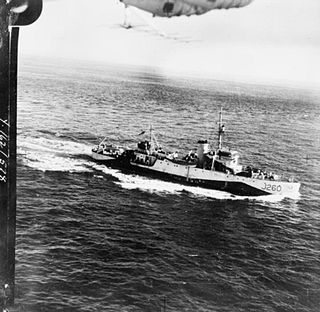Related Research Articles
Three Canadian naval units have carried the name HMCS Chignecto.
A motor minesweeper is a small minesweeper, powered by an internal combustion engine, very often of wooden construction, designed to locate and destroy mines in coastal waters and harbors. Many navies have used such ships.
Several Canadian naval units have been named HMCS Nipigon.
Several Canadian naval units have been named HMCS Cowichan;
Several Canadian naval units have been named HMCS Chaleur.
Several Canadian naval units have been named HMCS Ungava.
Several Canadian naval units have been named HMCS Thunder;

HMCS Goderich was a Bangor-class minesweeper constructed for the Royal Canadian Navy during the Second World War. Entering service in 1941, Goderich spent the entire war as a local convoy escort based out of Halifax, Nova Scotia. The vessel was decommissioned in 1945 and placed in reserve. Reacquired during the Korean War, the vessel was modernized but never re-entered service and was sold for scrap and broken up in 1959.
HMCS Mahone was a Bangor-class minesweeper constructed for the Royal Canadian Navy during the Second World War. Entering service in 1941, the ship took part in the Battle of the Atlantic and the Battle of the Saint Lawrence as a convoy escort. Following the war, the minesweeper was decommissioned and placed in reserve. Reacquired during the Korean War, Mahone was never recommissioned into the Royal Canadian Navy and was instead sold to the Turkish Navy in 1958. Renamed Beylerbeyi, the minesweeper remained in service until 1972 when she was discarded.
HMCS Quinte was a Bangor-class minesweeper constructed for the Royal Canadian Navy during the Second World War. The ship entered service in 1941 and took part in the Battle of the Atlantic. On 30 November 1942, Quinte ran aground and sank off Cape Breton Island. The ship was re-floated and repaired and spent the rest of the war as a training ship. Following the war, the minesweeper was used for naval research until decommissioned in 1946. The vessel was sold for scrap and broken up in 1947.
HMCS Ingonish was a Bangor-class minesweeper initially constructed for the Royal Navy during the Second World War. Loaned to the Royal Canadian Navy in 1942, the vessel served on both coasts of Canada as a convoy escort and patrol vessel. Following the war, the minesweeper was returned to the Royal Navy and laid up. Ingonish was discarded in 1948.
HMCS Lockeport was a Bangor-class minesweeper initially constructed for the Royal Navy during the Second World War. Loaned to the Royal Canadian Navy in 1942, the minesweeper saw service on both coasts of Canada as a patrol vessel and convoy escort. Returned to the Royal Navy in 1945, Lockeport was discarded in 1948.
HMCS Medicine Hat was a Bangor-class minesweeper that served with the Royal Canadian Navy during the Second World War. Entering service in 1941, the minesweeper was primarily used as a convoy escort in the Battle of the Atlantic and the Battle of the St. Lawrence. Following the war the vessel was laid up until reacquired during the Korean War. Never re-entering service with the Royal Canadian Navy, Medicine Hat was sold to the Turkish Navy in 1957. Renamed Biga, the minesweeper was discarded in 1963.
HMCS Swift Current was a Bangor-class minesweeper that served with the Royal Canadian Navy during the Second World War. Entering service in 1941, the warship used as a training ship and convoy escort and took part in the battles of the St. Lawrence and the Atlantic. Following the war the ship was laid up until reacquired during the Korean War. Never re-entering service with Canada, Swift Current was sold to the Turkish Navy in 1958. Renamed Bozcaada, the minesweeper was discarded in 1971.
HMCS Blairmore was a Bangor-class minesweeper that served with the Royal Canadian Navy during the Second World War. Entering service in 1942, the ship took part in the Battle of the Atlantic and the invasion of Normandy. Following the war, the ship was laid up until 1958 when the Blairmore was transferred to the Turkish Navy. Renamed Beycoz, the vessel was discarded in 1971.
HMCS Fort William was a Bangor-class minesweeper that served with the Royal Canadian Navy during the Second World War. Entering service in 1942, the minesweeper participated in the Battle of the Atlantic as a convoy escort and in the invasion of Normandy. Following the war, the ship was laid up, but was reacquired during the Korean War. Fort William never re-entered service with the Royal Canadian Navy and in 1957, was sold to Turkey. Renamed Bodrum by the Turkish Navy, the ship was discarded in 1971.
HMCS Kenora was a Bangor-class minesweeper that served with the Royal Canadian Navy during the Second World War. Entering service in 1942, the minesweeper took part in the Battle of the Atlantic as a convoy escort and in the invasion of Normandy. Following the war, the vessel was laid up until reacquired in 1952 during the Korean War. Never re-entering service with the Royal Canadian Navy, Kenora was sold to the Turkish Navy in 1957. Renamed Bandirma by the Turkish Navy, the vessel was discarded in 1972.
HMCS Westmount was a Bangor-class minesweeper that served with the Royal Canadian Navy during the Second World War. Entering service in 1942, the minesweeper spent the entire war on the Atlantic Canada coast. Following the war, the ship was laid up in reserve until reacquired in 1952 during the Korean War. Never re-entering service with the Royal Canadian Navy, the vessel was sold to the Turkish Navy in 1958. Renamed Bornova, the minesweeper was discarded in 1972.
HMCS Quinte was a Bay-class minesweeper that served in the Royal Canadian Navy during the Cold War. Entering service in 1954, the minesweeper was the second ship to bear the name. The ship was taken out of service in 1964 and declared surplus in 1965.
Several Canadian naval units have been named HMCS Gaspé;